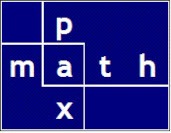– Robert Lamm, Chicago
The mathematically curious probably even considered calculating the crossing times.
I know of two ways to calculate the crossing times and both are easy.
(2) Algebra
Here are two bonus questions:
- At what times are the two hands perpendicular to each other?
- At what times are the two hands opposite each other?
Observe the clock hand movements for a while and notice that after 12:00, the minute and hour hands cross 11 times in 12 hours.
Therefore, the crossings divide the 12 hours into 11 equal parts or intervals of time. Remember that each hand moves at a constant angular rate (steady circular movement).
Therefore, each interval must be ![]() hours.
hours.
![]() hours at the 1st crossing
hours at the 1st crossing
![]() hours at the 2nd crossing
hours at the 2nd crossing
And so forth.
Let’s define terms.
![]() : angle measure of a full circle; measured from straight-up 12:00
: angle measure of a full circle; measured from straight-up 12:00
![]() ,
, ![]() ,
, ![]() , etc: number of hours
, etc: number of hours
![]() : crossing count
: crossing count
 for the crossing after 1:00
for the crossing after 1:00 for the crossing after 2:00
for the crossing after 2:00- And so forth
The hour hand completes a circle in 12 hours, therefore:
- the angular rate of the hour hand is

- the angular location of the hour hand is

The minute hand completes a circle in 1 hour, therefore:
- the angular rate of the minute hand is therefore

- the angular location of the minute hand is
 ;
;
the expression provides an angular position
provides an angular position 
Setting the two locations equal after one hour, the equation is:
![]()
![]()
![]()
![]()
![]()
![]()
Setting the two locations equal after two hours, the equation is:
![]()
![]()
![]()
![]()
![]()
![]()
Therefore, the general solution after ![]() hours is:
hours is:
![]()
![]()
![]()
![]()
![]()
![]()


